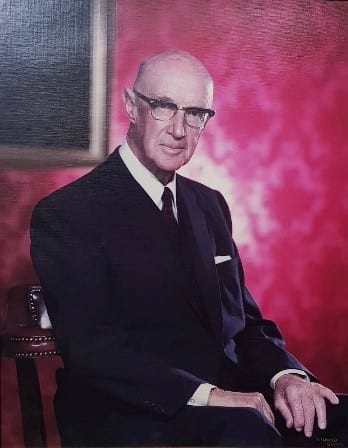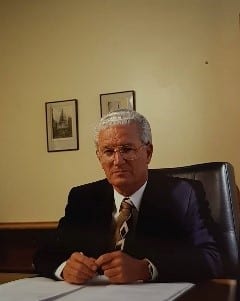The origins of the Goodfellow Unit lay in a discussion between businessperson and philanthropist Douglas Goodfellow and his second cousin, surgeon and the then Associate Dean of Graduate Studies in Medicine at the University of Auckland, Dr Campbell Maclaurin.
On 8 July 1977, Douglas Goodfellow spoke with his relatives about the prospect of offering an endowment to mark the fiftieth anniversary of Amalgamated Dairies Ltd. Goodfellow served as the company’s Chair and Managing Director. He proposed the endowment to commemorate his father and the company’s founder, Sir William Goodfellow.
By the 1970s, the Goodfellow family had already made substantial contributions to the University of Auckland. In 1947, Sir William Goodfellow established The Maclaurin Chapel to honour his son, Lieutenant Richard Maclaurin Goodfellow, who had been killed during World War Two, and his brother Richard Cockburn Maclaurin, who had been the president of the Massachusetts Institute of Technology from 1909 to 1920. The Goodfellow family had also established scholarships for students enrolled at the University of Auckland and donated to other groups including St Kentigern College and the Auckland War Memorial Museum.

Sir William Goodfellow, (1880–1974)

William Douglas Goodfellow, (1917–2014)
Campbell Maclaurin had an idea. Two years earlier in 1975, he had appealed to the University of Auckland to appoint a Director of Postgraduate Medical Education in General Practice. As Associate Dean of the School of Medicine, Maclaurin was responsible for advancing medical activities ‘in the best way I could’. He reported that the high number of GPs in New Zealand, coupled with the lack of existing opportunities for continuing medical education meant that general practice ‘seemed to be a sensible place to start’. 1 Nevertheless, the University of Auckland denied his request for funding. The idea lay dormant until his discussion with Douglas Goodfellow two years later in July 1977.
Douglas Goodfellow was considerably more receptive than the University to the prospect of establishing a senior academic position to develop continuing medical education for GPs. Dr Bruce Goodfellow, Douglas’ son and the current Chair of the Goodfellow Foundation, has explained that Maclaurin’s suggestion was ‘probably the best thing that anybody said to him that really caught his imagination and that would have a lasting effect’. 2
The proposed appointment would facilitate further educational opportunities for GPs. It seemed to be an ideal way to commemorate Sir William Goodfellow. Bruce Goodfellow explained:
One of the things my father said to me is that my grandfather always wanted to make sure that he could access a good quality general practitioner at any time of the day. And the only way really was to give them postgraduate training because it just didn’t exist.
Bruce Goodfellow - Douglas Goodfellow
On 15 July 1977, Dr Maclaurin wrote to Vice Chancellor Colin Maiden to inform him of Douglas Goodfellow’s ‘extremely generous offer of financial support’.
He explained the endowment would ‘promote research into the educational needs of general practitioners, provide leadership and direction in the further development of appropriate educational facilities, courses, meetings, and other activities, and develop effective evaluation and assessment procedures to measure the results achieved’.3 The endowment would cover the salaries of a senior academic and a secretary for ten-years, after which time the University of Auckland would ideally accept responsibility for continuing to finance the positions.
On the evening of 9 August 1977, over five hundred people gathered at Trillo’s Downtown convention centre in Auckland city to celebrate the fiftieth anniversary of Amalgamated Dairies Ltd.
At this event, Douglas Goodfellow formally offered the contract of $250,000.00 to Vice Chancellor Maiden from the University of Auckland. He anticipated the fund would contribute to an improvement in the quality of medical care that would be of ‘lasting value to the community at large’, and hoped that their ‘action will act as a catalyst to similar developments in other centres of New Zealand’. 4

Dr Phil Barham, the inaugural Director of the Goodfellow Unit
In 1978, the University Council appointed Dr Phil Barham as the inaugural Sir William Goodfellow Director of Continuing Medical Education in General Practice. Within the first decade, additional funding from Douglas Goodfellow and external organisations enabled the University to appoint research staff and to transform the single Directorship into the Continuing Medical Education in General Practice Unit. It became known as the Goodfellow Unit by 1987.
Douglas Goodfellow’s generosity was not only instrumental to the development of the Goodfellow Unit, but also to its continuation. He had initially offered to fund the salary of the Director and secretary for ten years until 1988. In the early-1980s, however, he received news that the University of Auckland would not be able to finance the positions from 1988 as planned. He subsequently agreed to extend funding for a further five years to 1993.
Yet concerns about limited funding from the University of Auckland emerged once again in the late-1980s and threatened the continuation of the Goodfellow Unit. Dr David Cole, who served as the Dean of the Auckland School of Medicine from 1974 to 1989, had reportedly agreed that the School would cover the costs of the Goodfellow Unit from 1993 onwards. In 1989, however, his successor Dr Derek North explained that the increasing demands for more staff within the School of Medicine meant the School could only afford to cover 2/10 of the Director’s salary. 5
If the Goodfellow Unit were to survive, it would have to generate enough income to cover the rest of the Director’s salary, and the salaries of all other staff.
Consequently, in January 1991 the University of Auckland Postgraduate Medical Committee established the Postgraduate Society Goodfellow Trust ‘for the permanent support of the Goodfellow Unit’. The Committee emphasised the value of the Goodfellow Unit and formed the Trust’s funds using its own reserves, and money the Goodfellow Unit had accumulated through sponsorship, income from the courses, the Journal Review Service, and external contracts.6 They hoped the establishment of the Trust – which became the Goodfellow Foundation in 1992 – would enable the Unit to become financially self-sufficient by the time funding from Douglas Goodfellow expired at the end of 1992.
GPs also rallied to support the continuation of the Goodfellow Unit. In December 1991, Dr Murdoch Herbert, the president of the Royal New Zealand College of General Practitioners, agreed to chair the organising committee for the Goodfellow Unit appeal. Dr Herbert had ‘watched with admiration the steady growth and expansion of the unit’ and declared ‘we must preserve this unit at all costs, particularly with the present emphasis on postgraduate education and quality assurance’.7 By the end of 1992, the fundraising committee had received donations from hundreds of GPs, the RNZCGP, and from Douglas Goodfellow.8
Such efforts to make the Goodfellow Unit self-sufficient proved to be successful. In January 1993, the Goodfellow Foundation became responsible for funding the salaries of the Director and support staff. The Foundation continues to fund part of the Director’s salary and various initiatives within the Goodfellow Unit.

L-R Campbell Maclaurin, Ross McCormick, Peter Huggard and Bruce Goodfellow at the
The relationship between the Goodfellow Unit and the University of Auckland also became more formalised from the early-1990s. In 1992, the Goodfellow Unit became a formal entity within the Department of General Practice, having transferred to the newly established Department from the Division of Postgraduate Affairs in the School of Medicine five years earlier in December 1987.9 Yet some trustees of the Goodfellow Foundation became concerned with the limited space to accommodate the growth of the Goodfellow Unit within the Department of General Practice, the limited independence of the Director, and income retention.10 Prevailing tensions with the University of Auckland led some trustees to consider separating from the University entirely. They started to look for alternative venues on Grafton Road.11 Ultimately, however, they decided it would be a ‘retrograde step’ to remove themselves from the ‘banner of Auckland University’. The move would also consume all available funds without leaving any money for the Unit to operate.12
In 1996, the Goodfellow Unit, the University of Auckland, and the Royal New Zealand College of General Practitioners signed the first Memorandum of Agreement to outline the management structure and the responsibilities of each party. Bruce Goodfellow explained that ‘up until then everything was basically by word and there was nothing really written down that gave a binding direction of what was happening … I think that is one of the most important moves that actually happened’. While the Goodfellow Unit generates funding, the Royal New Zealand College of General Practitioners ‘has supported us in more a moral aspect of what we’re doing’, and the University of Auckland ensures the Unit provides quality academic research. They signed subsequent agreements in 2002, 2008 and 2013.
Bruce Goodfellow - Memorandum of Agreement
Campbell Maclaurin’s and Douglas Goodfellow’s efforts to establish a senior appointment within the School of Medicine set the groundwork for the Unit that developed over the next four decades. Yet developing a system of continuing medical education that was both appealing and accessible to GPs across and beyond Auckland was not an easy task.
- 1. Interview with Campbell Maclaurin, 11 September 2018. ↩
- 2. Interview with Bruce Goodfellow, 20 December 2018. ↩
- 3. Letter from Campbell Maclaurin to Colin J Maiden, 15 July 1977. ↩
- 4. Douglas Goodfellow, ‘Chairman’s Address on the Occasion of the 50th Jubilee of Amalgamated Dairies Limited’, speech, 9 August 1977. ↩
- 5. Philip Barham, Goodfellow Unit Report, 1992, 3. ↩
- 6. Letter from Campbell Maclaurin, Philip Barham, and Brian McAvoy to Mr Nicoll, Registrar at the University of Auckland, 11 December 1991. ↩
- 7. Letter from Murdoch Herbert to Campbell Maclaurin, 10 December 1991. ↩
- 8. The Goodfellow Unit, A review, 1997. ↩
- 9. Letter from Campbell Maclaurin and Philip Barham to Colin Maiden, 3 November 1987. ↩
- 10. Campbell Maclaurin, A History of the Development of the Goodfellow Unit, 1978-2003, unpublished document, 4. ↩
- 11. Ibid., 5. ↩
- 12. Interview with Bruce Goodfellow. ↩
